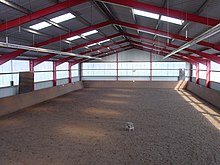Riding arena




A riding arena is a building (part of an equestrian facility ) that is specially designed for equestrian sports .
architecture
Riding arenas are constructed taking the following criteria into account:
- The riding arena must be as large as possible (although smaller halls offer the advantage of having to bend the horses more for dressage work).
- No pillars are allowed in the riding arena; except pillars .
- The hall must have high, wide and easy-to-open gates, whereby the opening of the gates or the boards should not go into the hall if possible.
- The incidence of daylight should be allowed over a large area and also from above.
Riding halls allow riders and horses to move around regardless of the weather. Riding halls can be found in different forms of construction. The most common constructions are: Laminated wood beams on wooden or steel girders, steel trusses or half-timbered trusses, lined or clad with trapezoidal sheet metal / sandwich elements. The roofs are usually made of sandwich elements or, in older riding arenas, made of fiber cement corrugated sheets. Often you can also find pit stalls towed to the hall. Riding tents are also increasingly being set up. These textile structures usually consist of an aluminum construction and a high-strength PVC-coated tarpaulin roof as well as wind protection nets in the walls.
The construction of riding arenas in the German-speaking area is subject to approval.
Others
Riding arenas are usually unheated, as this is healthier for the horses, and usually have tournament dimensions of 20 m × 60 m or of 20 m × 40 m and 25 m × 65 m.
The quality of the soil is of great importance in riding arenas. A good riding surface needs uniform humidification for dust binding, maintenance of the riding surface and maintenance of riding ability, which can be guaranteed by an automatic riding surface irrigation - watering from above - or by an adjustable flooding - watering from below, so-called ebb and flow systems.
Particular attention should be paid to lighting. The horses' sense of light and dark makes uniform lighting necessary. Artificial light should be generated glare-free and diffuse, and the light intensity should be adjustable depending on the riding discipline .
Special purpose halls
A lunging hall is a smaller hall for lunging horses. Most lunging halls are round and have a diameter of 16–24 m. Angular models have advantages in terms of construction costs and allow the horses better spatial orientation. Lunging halls are structures that require approval.
Famous riding arenas
- Spanish Riding School , Vienna
- Royal Riding Hall , Hanover
- Marstall Munich (today's "Marstall" building is only the former riding hall)
- Munich riding arena
- University Riding School Munich
- Reithalle cultural center , Bern
- Coburg riding arena
- Rythalle Solothurn
See also
literature
- Wolfgang Götz: German baroque stables . Munich 1964.
- Liliane Skalecki : The riding house. Investigations into a building project in the 17th to 19th centuries . Olms, Hildesheim 1992 (Studies on Art History, 76), ISBN 3487096315 .
- Gerlinde Hoffmann / Deutsche Reiterliche Vereinigung (FN): Orientation aids for equestrian facilities and stable construction, (p. 116 Longierhalle), Warendorf 2009, ISBN 978-3-88542-740-7
- Helmbrecht Boege: Construction of building envelopes for horse keeping, in Building Letters Agriculture No. 49 - Horse keeping, Deutsche Landwirtschaftsverlag, Hanover, p. 88ff


